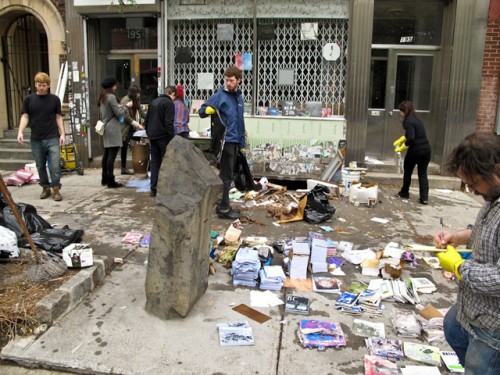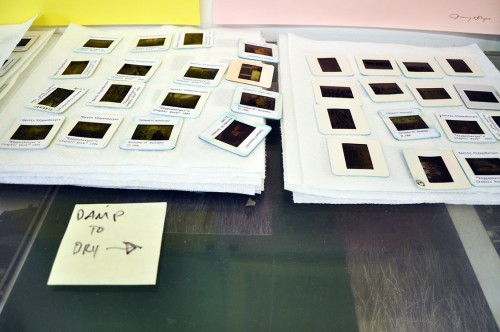
Printed Matter cleaning waterlogged works outside its storefront in Chelsea. Image via Hyperallergic.com.
Last week in Red Hook, I was visiting the works that were still left over from the Flooded Art Party; artists had collected some of their Sandy-ravaged artworks, and other works had been sold as part of the relief benefit. At the end of my tour, I asked if Z and Charlotte, two artists whose studios, works and homes were damaged by the storm, had looked at other resources for relief beyond fundraising on their own. Charlotte said something to the effect of, “applying for grants takes a whole different kind of emotional energy and patience” that was hard to gather after grieving and trying to put one’s daily life back together.
Christy MacLear, the Executive Director of the Rauschenberg Foundation, was not surprised when I relayed this experience to her. She says that with allocating grants following catastrophes, the action of distributing funds occurs in waves, corresponding to the period of time in which people must first take measure of the invaluable loss before they can quantify it. It’s why some emergency funds tend to stay open for a considerable amount of time.
It was announced last month that the Rauschenberg Foundation, the Warhol Foundation and the Lambent Foundation have pooled resources to set up a fund distributing grants to organizations in need (NYFA is handling parallel distributions to artists). I was nervous calling Ms. MacLear not only during her busy week of reviewing grants but also during the bustle of Miami’s art fairs. She explained to me with calming unhurriedness, though not without gravity, that the magnitude of loss has been shocking for everyone at the Foundation. She said that she noticed two extremes of tragedy: some organizations experienced catastrophic material losses beyond what grants alone can amend, and others have uninsurable losses of historic archives that can’t be fully fathomed. (Think about Smack Mellon and Printed Matter as one of numerous examples of each). Ms. MacLear added that the loss of revenue for organizations at every size has put businesses and livelihoods in precarious situations. The funds, she believes, will aid in a variety of ways.
Days earlier, I spoke to Holly Greenfield, who runs the department for non-profit and benefit auctions at Paddle8. Paddle8’s offices are located in a neighborhood in lower Manhattan that had lost power for over a week, and I asked how the storm affected her department—both as an operation and as a resource for other organizations. She responded with inspiring energy that while four benefit auctions had to be rescheduled, a portion of the sales will be going towards hurricane relief. They have currently organized two sales dedicated to aid victims affected by Hurricane Sandy; “On the Blocks: A Chelsea Revival Sale” invited Chelsea galleries to utilize the online platform to hold a 5-work benefit auction, and “Re.Start” was a sale of commissioned artworks from which 100% of Paddle8’s commissions went towards Creative Time and NYFA’s relief efforts.
From both conversations, it seems as though the relief will help some get back on their feet entirely, but will only be the beginning of a long rebuilding process for others. Ms. Greenfield put it more eloquently than I could: “The need for support will change as the months and years go by. The first phase of relief will be more relevant for immediate needs from artists and organizations. The second phase will need to address more sustained and long-lasting damage, which will be harder and more costly to implement.”
When I asked Ms. MacLear and Ms. Greenfield about their visions of the future, I was met with serious yet optimistic answers that seemed largely in accord. Ms. MacLear said that this storm “reshapes the industry—not just geographic locations, but also the approaches.” Ms. Greenfield elaborated on the same idea: “This moment reveals how fragile things can be for artists an organizations without significant cushions to fall back on, and has the potential to encourage broader systems of support to prevent the worst from happening when catastrophes strike.” The Rauschenberg Foundation helped fund the Ballroom Marfa to bring a symposium on climate change, which Ms. MacLear thinks is timely; she considers it “funding the knowledge and education of the infrastructure.”
Are there any upsides to be found in the aftermath of the hurricane? Ms. MacLear brightened: “It’s a way to get out of your groove and try different approaches—you have to clear out and re-set up, and start again.”
For information and grant applications for the fund set up by the Rauschenberg Foundation, the Warhol Foundation and the Lambent Foundation, please see Emergency Grants. Please see here for information and applications for NYFA’s Relief Fund. In the meanwhile, MoMA NY is also offering Sandy-related art conservation resources.




